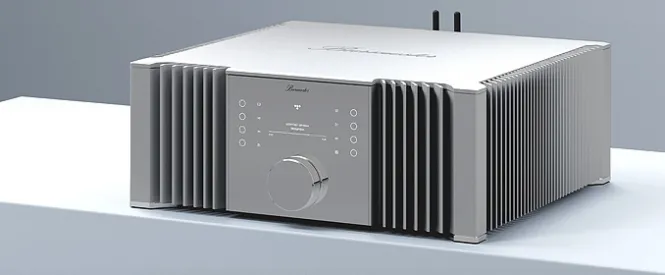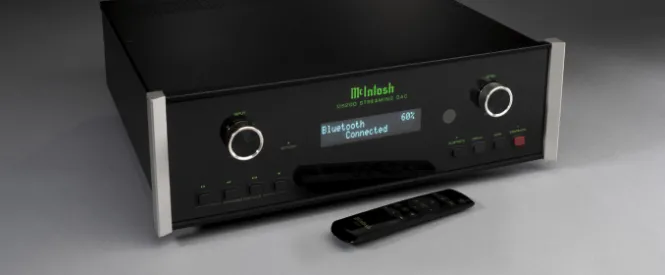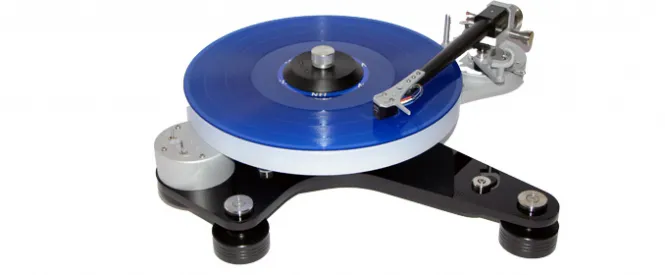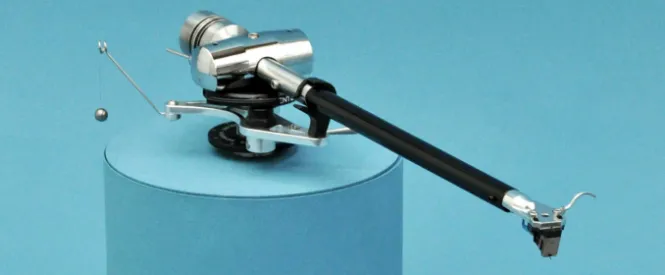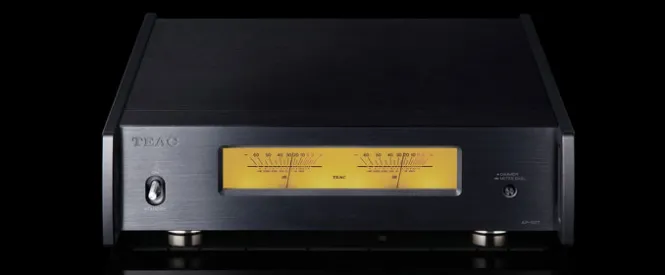Sony X95L 65” Bravia XR Mini LED 4K UHD TV Review
Steve May goes starry-eyed at this superb new Mini LED 4K flatscreen TV…
Sony
Bravia XR-65X95L
65-Inch Mini LED 4K UHD Smart TV
£2,399 RRP
Sony's new X95L could well be the TV that convinces you that you don't actually need to go OLED for your next big screen upgrade. This well-equipped Mini LED flatscreen offers high-level HDR handling, with bright peak highlights and surprisingly effective blacks, exceptional picture detail with both native UHD and HD sources, and a novel audio system that literally turns the frame of the TV into a speaker of sorts.
It also runs the latest Google TV smart platform, and has unique PlayStation 5 compatibility modes, specifically Auto HDR Tone Mapping and Auto Genre Picture Mode. All in all, this is a very potent recipe. The Sony comes in three screen sizes: 65-, 75- and 85-inches, aka the XR-65X95L, XR-75X95L and XR-85X95L.
UP CLOSE
We have the 65-incher on our test bench, and it's quite a handful, weighing in at a hefty 32.2kg. Although it's not quite the slimmest of TVs, the seamless edge bezel wrap has been nicely executed. There's next to nothing between its pictures and thin air. The back panel features the familiar Sony check pattern, which helps disguise the whereabouts of the compartments that conceal its various connections.
Sony branding is admirably discrete, with a logo located at the bottom of the screen, and the pedestal feet can be either narrowed or widened to best suit your AV furniture. The screen can also be raised if you need to make room for a soundbar.
Inputs comprise four HDMI, two supporting 4k @ 120Hz sources (HDMI 3 and 4). Unfortunately, the third HDMI is also the eARC connection, which rather reduces your options if you want to hook up a second HFR-capable games console. There is support for VRR and ALLM, but latency is best regarded as average. I measured input lag at 17.1ms in Game mode (1080/60).
We also get a digital optical audio output, two USB ports, plus Ethernet LAN to support Wi-Fi. There are tuner options for both terrestrial and satellite. In the UK, this translates to YouView on the former (because there is no certification from the governing DTG for Freeview Play to work with Google TV), and Freesat. There's also a CI slot for those who need it. Wireless support includes Apple AirPlay and Homekit.
The set ships with two remote controls. There's the standard button-strewn IR zapper, and a slimmer Bluetooth remote, with dedicated buttons for Bravia Core, Netflix, Disney Plus, Prime Video, YouTube and Crunchyroll services.
IN USE
In case you've yet to come across it, Google TV is a derivation of the popular Android smart TV platform, differentiated by a more concentrated approach to content curation. It provides swift access to preferred streaming apps, and offers rail upon rail of content recommendations. There's a Continue Watching rail, Top Selling movies to pay per view rail, Prime Video content rail, as well as a rail for newly uploaded YouTube videos from your subscriptions. It neatly dovetails into Sony's own menu navigation system, which is relatively intuitive to use. Catch-up apps can be accessed from within YouView.
In addition to all the usual streaming services, owners can also stream movies from Bravia Core, Sony's own high-bitrate (up to 80Mbit) on-demand movie service. This features movies that are both 4k encoded as well as IMAX Enhanced. You're supplied with ten credits to spend on this out of the box, but once you've burnt through them, you'll be paying to view. With gamers in mind, Sony offers a dedicated Game Menu interface. This gathers all related gaming settings into one bar, to make it easier to monitor the state of play.
VISION ON
The X95L impresses straight from the box. Taking a lot of the credit for this is Sony's Cognitive Processor XR technology, which makes dynamic adjustments to contrast, black level detail, high peak brightness and colour fidelity. We've seen other brands rush to replicate Sony's picture processing approach, but in a nutshell, Cognitive XR makes intelligent assumptions about what you're watching at any given time, and applies maximum processing effort to optimise the focal point of any given image.
The Mini LED backlight – a backplane peppered with thousands of tiny LEDs – is surprisingly uniform in delivery. XR Backlight Master Drive technology is charged with fine-tuning black levels and near-shadow detail, while XR Triluminos Pro handles colour performance.
The set's various picture processing modes include IMAX Enhanced, Custom, Cinema, Standard and Vivid, Dolby Vision (but not Dolby Vision IQ), and Netflix Adaptive Calibrated. If you're watching Dolby Vision content, preset options default to Dolby Vision Dark, Dolby Vision Bright and Vivid modes, but there's no Dolby Vision Game mode.
HDR performance of the X95L is excellent, easily exceeding the typical HDR mastering specification for broadcast content. Sony has boosted the number of dimming zones on this model by 30 percent, compared to last year's Mini LED debut, and this has resulted in both a significant increase in brightness, plus better uniformity and HDR precision.
I measured peak HDR brightness at around 1600 nits using both a 5 percent measurement patch and larger 10 percent window (1626 nits and 1589 nits, respectively) using the Standard preset. It's possible to squeeze a little more luminosity if you prefer the Vivid setting, but this comes with a level of colour over-saturation that you may feel uncomfortable with. If you opt to watch using Sony's reference grade Custom setting, HDR peak brightness drops to a still impressive 1396 nits peak brightness.
HDR handling is admirable. There's a distinct lack of overt halos around bright objects on a black background; indeed, black-level performance is often comparable to OLED when it comes to inky darkness and precision, although you'll need to watch in a room with some ambient light for the best experience. In a fully dark environment, deep blacks begin to grey out.
The X95L looks gorgeous with Blu-ray and 4k streaming services, but the set doesn't need native 4k sources to impress. Sony's own XR 4k Upscaling and XR Clear Image technologies work wonders with HD TV and disc, improving subjective clarity and reducing image blur and noise.
The screen also has an X-Anti Reflection coating and X-Wide Angle treatment, which makes room placement less challenging than might otherwise be the case. It's obviously still best to sit square-on, but those watching from an angle won't lose too much when it comes to contrast and colour. Indeed, the X95L's colour performance is often breathtaking. It's able to push the colour gamut to almost wild vibrancy, yet still manages to offer convincing skin tones and natural textures.
The X95L is at its most accurate when in Custom mode. It's here that it's tuned to closely mirror what would be seen on a mastering suite monitor. Of course, your living room is probably quite unlike a mastering suite in terms of lighting and viewing distance, so sometimes greater picture pop is appreciated. That's when Standard rises to the occasion. It's a great catch-all for most content.
Motion handling, the long-time strength of Sony picture processing, remains impressive. While I wouldn't opt for MotionFlow smoothing when viewing movies, it's effective on live sports and TV studio fare.
The set features an Acoustic Multi-Audio+ audio system, with Dolby Atmos support. Sony actually uses the frame of the TV as a sound source, using actuators to create a 'frame tweeter', in addition to a traditional TV speaker array. The end result is a larger soundstage with good localisation. Dialogue appears to be coming from the screen area, and visual movement is echoed by sonic panning. The set is light on bass though, and can sound brittle at volume.
If you want to make more of the set's audio, you can take advantage of Acoustic Centre Sync. This works with select Sony soundbars and allows the X95L's speakers to work in harmony with the soundbar to offer greater clarity and a more blended soundstage. Alternatively, you can simply eARC audio out to a standalone audio system.
THE VERDICT
Sony's new X95L is a fine all-round 4k display, offering high levels of detail and colour vibrancy, coupled to impressively bright HDR highlights. The black level of this Mini LED model is surprisingly good, but still can't match OLED in a fully dark viewing room.
While the screen offers a welcome level of compatibility with Sony's PlayStation 5, the lack of a 4k 120Hz input support across the whole HDMI board is a telling limitation. It's a shame Sony didn't elect to offer even basic ARC on one of the two HDMI inputs that don't support high frame rate gameplay to widen options for gaming enthusiasts. Still, overall AV performance is high, and the Google TV platform is solid. This classy second-generation Mini LED big screen is well worth shortlisting for movies and everyday telly watching.
For more information visit Sony
Steve May
Steve is a home entertainment technology specialist. Creator of Home Cinema Choice magazine, Steve is also the editor of the lifestyle website The Luxe Review and has an unconditional love of glam rock.
Posted in: Visual | Televisions | Visual
JOIN IN THE DISCUSSION
Want to share your opinion or get advice from other enthusiasts? Then head into the Message
Forums where thousands of other enthusiasts are communicating on a daily basis.
CLICK HERE FOR FREE MEMBERSHIP
Trending
applause awards
Each time StereoNET reviews a product, it is considered for an Applause Award. Winning one marks it out as a design of great quality and distinction – a special product in its class, on the grounds of either performance, value for money, or usually both.
Applause Awards are personally issued by StereoNET’s global Editor-in-Chief, David Price – who has over three decades of experience reviewing hi-fi products at the highest level – after consulting with our senior editorial team. They are not automatically given with all reviews, nor can manufacturers purchase them.
The StereoNET editorial team includes some of the world’s most experienced and respected hi-fi journalists with a vast wealth of knowledge. Some have edited popular English language hi-fi magazines, and others have been senior contributors to famous audio journals stretching back to the late 1970s. And we also employ professional IT and home theatre specialists who work at the cutting edge of today’s technology.
We believe that no other online hi-fi and home cinema resource offers such expert knowledge, so when StereoNET gives an Applause Award, it is a trustworthy hallmark of quality. Receiving such an award is the prerequisite to becoming eligible for our annual Product of the Year awards, awarded only to the finest designs in their respective categories. Buyers of hi-fi, home cinema, and headphones can be sure that a StereoNET Applause Award winner is worthy of your most serious attention.

